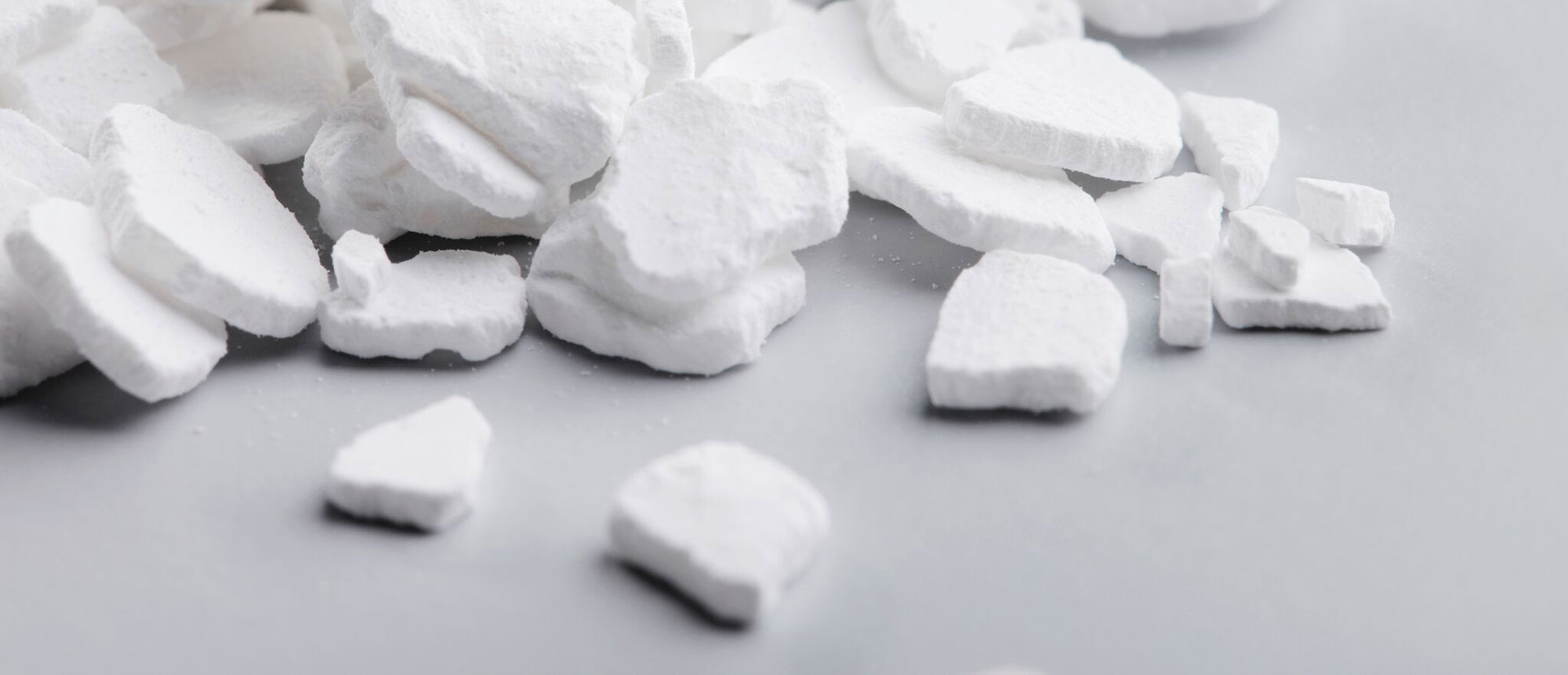Calcium Chloride Formula
Calcium chloride is a chemical often referred to as a salt. In chemistry, the term salt refers to a compound featuring an ionic bond between a cation and an anion. Ionic bonds form between elements with significant differences in electronegativity, or their ability to attract electrons. Cations form through the loss of electrons, resulting in a positive charge, while anions form by gaining electrons, resulting in a negative charge.
When calcium chloride forms, it does so through the exchange of electrons between calcium and chlorine. Calcium donates its two extra electrons to chlorine, and the resulting positive and negative charges on the atoms bind them together in an ionic bond. However, one important question remains: in one calcium chloride molecule, how many calcium atoms and chlorine atoms are there?
This can be determined using the principle of electroneutrality. The molecule as a whole wants to be charge neutral. Calcium arrives at the bond with two electrons to donate. Chlorine, on the other hand, only seeks one additional electron. In order for the bond to be stable, a second chlorine atom joins it, allowing the calcium to donate one electron each to both chlorine atoms. The result is a charge-neutral molecule.
A short way to determine the number of each element in one molecule is by looking at the charges as written. A calcium cation is written as Ca2+. A chlorine anion is written as Cl1-. For a simple molecule like calcium chloride, it is possible to simply swap the charges on each element and apply them as subscripts. In other words, take the 2 from Ca and place it on Cl as Cl2, and take the 1 from Cl and place it on Ca as Ca1.

Either method will lead to the formula CaCl2. To complete the formula of hydrated calcium chloride, H2is added to the formula in parentheses.
This leaves the formula for hydrated calcium chloride as CaCl2.
Save Timeline Autoplay Speed Normal
Video Quiz Course
36K views
Name of the Compound CaCl2
The metal (or cation) in calcium chloride is calcium, and the nonmetal (or anion) is chlorine. Because this salt is very simple, containing only one element acting as a cation and one acting as an anion, naming the ionic compound is also simple.
First, write the name of the cation as it is written on the periodic table. Thus, the first word in the compound’s name is ”calcium.”
Next, identify the name of the anion. The latter part of the anion’s name is replaced with ”-ide.” So, chlorine becomes ”chloride.”
Since the ratio of cations to anions is easily found by looking at the elements’ charges, no prefixes are added to the name to show how many atoms of each element are present in one molecule.
The name of CaCl2 is calcium chloride.
Structure of Calcium Chloride
As a salt, calcium chloride forms a crystalline structure. The atoms arrange themselves in a lattice to optimize the attraction between cations and anions and alleviate the repulsion between two cations and two anions.
Anhydrous calcium chloride as white crystals.
A dish of anhydrous calcium chloride.
Hydrous calcium chloride can have several different structures depending on the ratio of calcium chloride molecules to water. These structures also have their own unique names. Monohydrate calcium chloride contains one water molecule for every calcium chloride molecule; dihydrate calcium chloride contains two water molecules for every calcium chloride; hexahydrate calcium chloride contains six water molecules for every calcium chloride, and so on.
Anhydrous calcium chloride has an orthorhombic crystal structure, while hexahydrate calcium chloride has a trigonal structure. At temperatures above 217 degrees celsius, the anhydrous form can exist at a tetragonal structure. The space groups of the anhydrous molecule are Pnnm for the orthorhombic structure and P42/mnm for the tetragonal structure. The coordination geometry of calcium in anhydrous calcium chloride is octahedral-6-coordinate.
Solubility of Calcium Chloride in Water
As a salt, calcium chloride is soluble in water. Around 75g of calcium chloride can be dissolved in 100ml of water at 20 degrees celsius, or at room temperature. Calcium chloride can also be dissolved in alcohol.
Grams of CaCl2 soluble in 100ml of water
Temperature, C 0 10 15 20 30 50 70 90
Calcium chloride, g 60 65 75 100 128 137 147 159
Uses of Calcium Chloride
Calcium chloride is a common manufacturing product used in many industries, including transportation and the food industry. One of the most common uses of calcium chloride is as a de-icer for roads. Adding salt to water depresses, or lowers, its freezing point. Calcium chloride is often applied to roadways to prevent water from freezing and forming ice, which can cause dangerous road conditions. Anhydrous calcium chloride also draws in water in large amounts during an exothermic, or energy-releasing, reaction. The energy is released as heat, which can further melt any ice that forms.
Road-Surfacing
The compound may also be applied to roads for a different purpose. Calcium chloride can be used to protect roads from breaking down when applied to the surface. This is also related to its water-attracting properties. The calcium chloride maintains a thin layer of liquid over the road, preventing dust from being scattered when the road is used and increasing the road’s longevity.
Food Additive
Many foods use calcium chloride as an additive, though its purpose is different depending on the product. As it contains calcium, an important electrolyte, it is often added to sports drinks to replenish calcium in the body. Its salty taste means it is often added to foods like pickles to increase their flavor without increasing its sodium content.
Calcium chloride is often used as an additive to make foods taste saltier.
Cucumbers that have been pickled.
Some foods make use of calcium chloride for reasons other than its taste. It is used to correct chemical imbalances when making cheese or beer and can be used to firm up canned foods such as vegetables.
Other Uses
Calcium chloride is sometimes used in medicine, for example when a patient has low levels of calcium, or hypocalcemia. Other uses include adding calcium chloride to concrete to speed up its setting process, treating swimming pool water to protect pumps from corrosion, using it as a thinning agent in fabric softener, and using it as an additive in plastics, fire extinguishers, and other commercial products.
Hazards of Calcium Chloride
As with any chemical, understanding the hazards of calcium chloride is invaluable when handling it. Anhydrous calcium chloride can cause irritation to the skin including redness and drying, pain in the eyes, burning in the mouth and esophagus, coughing, nausea, and vomiting. Many of these hazards are associated with its ability to absorb water, which can dry the water out of the skin and organs and cause pain and discomfort.
Additionally, calcium chloride can produce toxic chlorine gas when burned. Hydrous calcium chloride will interact with zinc, producing hydrogen gas, which is very flammable. For these reasons, calcium chloride must be stored carefully and handled while wearing gloves, a lab coat with fitted sleeves, and goggles.
Properties of Calcium Chloride
The dissolution of calcium chloride in water
CaCl2 + H2 O
Ca2+ (aq) + 2 Cl- (aq)
Reaction of calcium chloride and sodium phosphate
3 CaCl2 + 2 Na3 PO4
Ca3 (PO4)2 + 6 NaCl
Lesson Summary
Calcium chloride is a salt, formed by an ionic bond between a calcium cation and two anions. The bond forms because of the differing electronegativity between the two elements; calcium has low electronegativity, while chlorine has high electronegativity. The ratio of calcium atoms to chlorine atoms in the molecule can be determined using the principle of electronegativity, which states that molecules as a whole prefer to be neutral. A calcium cation has a charge of +2 attracts, and a chlorine anion has a charge of -1 each. To balance one another out, one calcium cation will attract two chlorine anions. This leads to the formula CaCl2.
As a salt, anhydrous calcium chloride typically forms an orthorhombic crystalline structure but can have a tetragonal structure at 217 degrees celsius and above. Calcium chloride can be dissolved in water owing to its ionic bonds, and hydrous calcium chloride can have alternate crystalline structures.
In industry, calcium chloride is used on roads for de-icing and road protection, and it is used as a food additive to improve flavor and replenish calcium electrolytes. It can be used to treat the condition hypocalcemiaor low calcium levels. In its laboratory form, its primary hazard is irritation to the skin and eyes.



